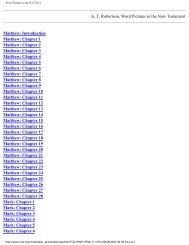Commentary on Joshua - Keil & Delitzsch - David Cox
Commentary on Joshua - Keil & Delitzsch - David Cox
Commentary on Joshua - Keil & Delitzsch - David Cox
You also want an ePaper? Increase the reach of your titles
YUMPU automatically turns print PDFs into web optimized ePapers that Google loves.
<strong>Keil</strong> and <strong>Delitzsch</strong> <str<strong>on</strong>g>Commentary</str<strong>on</strong>g> <strong>on</strong> the Old Testament<br />
<br />
4:29. Knobel identifies it with the present Deir Belah , some hours to the south-west<br />
of Gaza Rob. iii. App.; Ritter , Erdk. xvi. pp. 41, 42); but it cannot have been so far to<br />
the west, or so near the coast as this. Iim (or Ivvim, according to the Auei'm of the<br />
LXX) is probably the ruins of Beit-auwa ( Rob. iii. App.). Azem , which was also<br />
given up to the Sime<strong>on</strong>ites (Josh 19:3; 1 Chr<strong>on</strong> 4:29), is supposed by Knobel to be<br />
Eboda , the present Abdeh , eight hours to the south of Elusa , a c<strong>on</strong>siderable mass of<br />
ruins <strong>on</strong> a ridge of rock ( Rob. i. p. 287), because the name signifies firmness or<br />
strength, which is also the meaning of the Arabic name-a very precarious reas<strong>on</strong>.<br />
Verse 30-31. Eltolad , which was given to the Sime<strong>on</strong>ites (Josh 19:4), and is called<br />
Tolad (without the Arabic article) in 1 Chr<strong>on</strong> 4:29, has not been discovered. Chesil ,<br />
for which the LXX have Baithee'l , is probably, as Reland supposes, simply another<br />
name, or as Knobel suggests a corrupt reading for, Bethul or Bethuel , which is<br />
menti<strong>on</strong>ed in Josh 19:4 and 1 Chr<strong>on</strong> 4:30, between Eltolad and Hormah , as a town<br />
of the Sime<strong>on</strong>ites, and the same place as Beth-el in 1 Sam 30:27. As this name points<br />
to the seat of some ancient sanctuary, and there was an idol called Khalasa<br />
worshipped by the Arabs before the time of Mohamet, and also because Jerome<br />
observes ( vita Hilar. c. 25) that there was a temple of Venus at Elusa , in which the<br />
Saracens worshipped Lucifer (see Tuch , Deutsch. Morgenl. Ztschr. iii. pp. 194ff.),<br />
Knobel supposes Bethul ( Chesil ) to be Elusa, a c<strong>on</strong>siderable collecti<strong>on</strong> of ruins five<br />
hours and a half to the south of Beersheba (see Rob. i. p. 296): assuming first of all<br />
that the name el Khulasa , as the Arabs called this place, was derived from the<br />
Mahometan idol already referred to; and sec<strong>on</strong>dly, that the Saracen Lucifer<br />
menti<strong>on</strong>ed by Jerome was the very same idol whose image and temple Janhari and<br />
Kamus call el Khalasa. Hormah: i.e., Zephoth , the present Sepata (see at Josh<br />
12:14).<br />
Ziklag , which was assigned to the Sime<strong>on</strong>ites (Josh 19:5; 1 Chr<strong>on</strong> 4:30), burnt down<br />
by the Amalekites (1 Sam 30:1ff.), and still inhabited after the captivity (Neh 11:28),<br />
is supposed by Rowland to be the ancient place called Asluj or Kasluj , a few hours to<br />
the east of Zepata, with which Knobel , however, in a most remarkable manner,<br />
http://207.44.232.113/~bible/comment/ot/k&d/josh/jos95.html (1 of 3) [13/08/2004 01:18:38 p.m.]
















